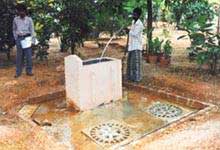A CITY`S THIRST
 Builder R Jeyakumar's technique is simple and cost-effective. The areas surrounding building complexes in Chennai are cemented. The rain water is allowed to flow on to the road. The first step, says Jeyakumar, is to prevent this run-off by two to three-inch-high kerbs near the gates. To collect the run-off, a 23-cm-wide, 12-cm-deep canal or trench is dug along the periphery of the plot. To catch rainwater, a series of bore pits are drilled along the drain. Each bore pit is connected to the drain through a slanting pipe. The bore pits are filled with broken bricks and sand or pebbles. A four-cubic cm collection chamber is provided on the top, filled with broken bricks and a 'silt-arrester'. Excess water flows into the bore pits and into the ground water aquifers.
Builder R Jeyakumar's technique is simple and cost-effective. The areas surrounding building complexes in Chennai are cemented. The rain water is allowed to flow on to the road. The first step, says Jeyakumar, is to prevent this run-off by two to three-inch-high kerbs near the gates. To collect the run-off, a 23-cm-wide, 12-cm-deep canal or trench is dug along the periphery of the plot. To catch rainwater, a series of bore pits are drilled along the drain. Each bore pit is connected to the drain through a slanting pipe. The bore pits are filled with broken bricks and sand or pebbles. A four-cubic cm collection chamber is provided on the top, filled with broken bricks and a 'silt-arrester'. Excess water flows into the bore pits and into the ground water aquifers.
Related Content
- Study on for unique pilot project to revive lakes
- To slake City's thirst, BWSSB favours Linganamakki water
- City thirsts for water-logging solution, says HC
- Cauvery won’t quench City’s thirst any more
- Go-ahead for sourcing quarry water to slake growing thirst
- Thumping increase: Delhi adds 5L vehicles in a year
